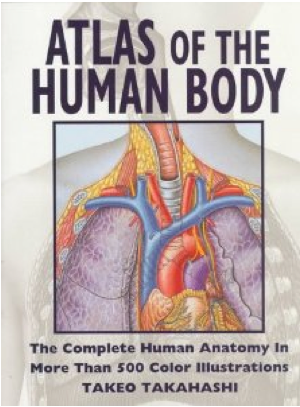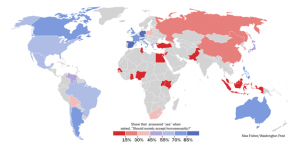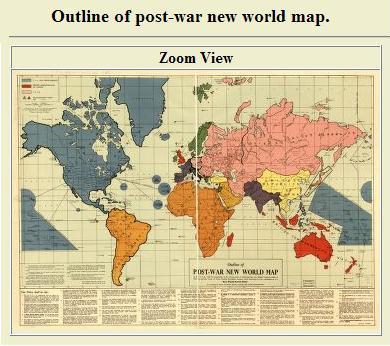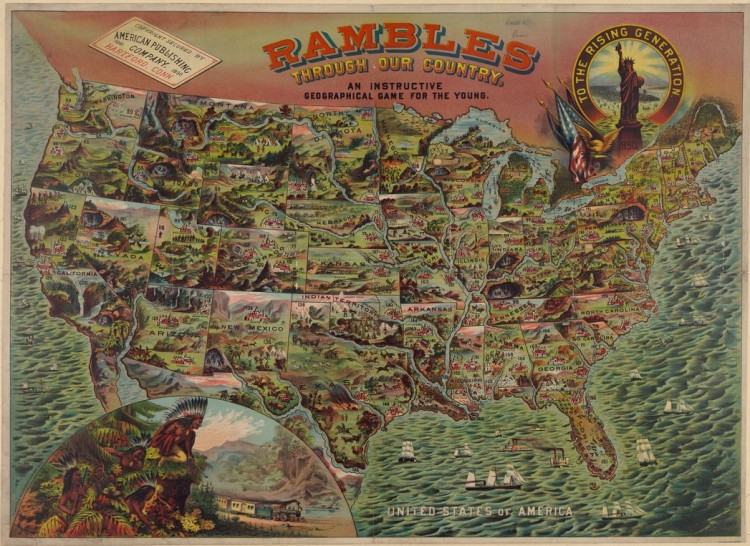The outrageous balloon-shaped countries on this map serve a purpose other than comic relief from a stressful day. In a remarkably straightforward tone, physics professor Mark Newman briefly defines how cartography presents social and economic aspects of the world, and he uses the cartogram entitled “Population” to assist his explanation[i]. Newman’s physics background may explain why he utilizes the cartogram in a matter-of-fact manner (because physics deals with inarguable laws of science), and it is difficult to view the map as argumentative. However, the map’s depiction of the world contains bold yet subtle statements of interest. Newman’s cartogram subtly illustrates that the world is negotiable, and it depicts how internal and external relationships of a map can have significant implications, even if the map appears to be objective. The map’s relationships argue a “correct” size for population, and they make claims about the agricultural resources of the world.
On the surface, the cartogram’s design seems odd and distorted because it inflates countries; nevertheless, it is a basic and potentially accurate representation of the world’s population: the greater a country’s population, the larger the country. China is the most populated country in the world; therefore, it is the largest country on the map. The audience of the map can make conjectures about the population of other countries based on their respective sizes. The intuitive function of this map coupled with general knowledge of country populations allows the map, as Newman describes, to effectively and naturally portray geographic and social data[ii]. Because one assumes the data that the map portrays is accurate, it is difficult to argue that the inflated representation of the countries is incorrect. The world has no set formation; as long as there is adequate supporting evidence, most arguments regarding the composition of the world are potentially valid. Countries with more people may have more influence within the world and therefore deserve larger visual representations.
The transformation from data to image involves intricate choices that cause this map to express arguments about population size and its significance. Dr. Barney, a professor of rhetoric and communications, accurately describes maps as abstract creations that present the world in scaled-down and simplified versions[iii]. The key word is “creation”: Newman’s map creates its own reality. Newman had to make choices that left out certain information, and selectivity makes arguments that attempt to define reality. For example, Newman increased the sizes of entire countries based on their populations, rather than highlighting population focal points. As a result, countries such as India, China and the United States appear to have booming populations that are evenly distributed; conversely, a high percentage of these populations may be within a small region. In contrast, Russia appears meager (if not entirely inferior) when compared to these three countries because of its small size; however, Russia’s total population is actually ninth in the world[iv]. Newman’s choices make rhetorically charged comparisons, which appear to create a dominance hierarchy among countries. Selectivity helps create the specific population arguments of this map.
Focusing on scale, the size of different countries has significant value. First (the elephant of the map), the sizes of China and India have several implications. The obesity of these two countries literally causes the natural waistline of the Earth (i.e., the equator) to sag. Meanwhile, the Americas hardly distort the equator. The sizes of these continents in coordination with the equator seem to be stating that the Americas have a “correct” sized population, while Asia is over-populated. The map is subtly telling India and China that they need to reduce their populations to be healthy. Another implication relates to the Indian Ocean. Because India is so large, it appears to be literally and figuratively “swallowing” the ocean. The map seems to be claiming that India will exhaust its water supply if its population continues to grow. The map makes these rhetorical arguments about the size of countries because of the scale that Newman selected.
This cartogram effectively illustrates the general ability for maps to shape the audience’s view of the world. Cartograms are blatantly non-traditional and are not objective on purpose: it attracts attention. Because this map is able to capture an audience’s attention, it is then able to make an impact on the way they view the world. Historian Susan Schulten notes that the natural world is “negotiable” because boundaries and borders are subject to change[v]. Because the world does not have a single defined structure, maps are able to make persuasive statements about its composition without being easily refuted. The depiction of the Earth within “Population” is non-traditional and may seem absurd at first, but this presentation is actually a plausible perspective. Large populations most likely have more influence than smaller ones; perhaps society should view countries with more people as dominant. This cartogram is able to make claims about the configuration of the world with an impressive subtlety. “Population” naturalizes itself among its audience, and then it attempts to shape the way they view individual countries.
Relationships are the interactions surrounding a map, which can be within a map or outside of it (e.g., colors to differentiate areas or external culture that interacts with a map). According to cartographer Denis Wood, relationships define maps, and inter-map relationships communicate the world while external relationships make claims about it[vi]. In other words, actual components of a map interact to create a depiction of the world, and audience interaction with a map gives it influence. Components of maps can simultaneously have internal and external significance. One key component of this map is color. Within the map, the various shades of green serve as country dividers. The inter-map relationships of the colors distinguish countries.
The colors gain considerable value when connected with external culture. Geographers Denis Cosgrove and Veronica della Dora explain that colors have extraordinary communicative capabilities[vii]. Green has symbolic qualities. Outside of the map, green typically represents agriculture; therefore, the shades of green seem to communicate which countries have agricultural stability. For instance, Mexico, Egypt and Indonesia are dark green while Ethiopia and Thailand are a color similar to the color of sand. Put in the context of external culture, colors transform from country indicators to agricultural symbols. The map appears to assert which countries are flourishing versus which countries are depleting their resources. Although these claims may be inaccurate, the previously established credibility of the map makes a reader less likely to argue with them. Through external relationships, the colors gain novel significance that makes bold claims about the condition of the world.
Mark Newman created the cartogram “Population” to aid his definition of cartography, but interestingly, the choices he made during the creation of the map make rhetorically charged and political arguments. The map argues and attempts to convince its audience that various countries need to reduce their populations; countries with large populations are depleting their natural resources and suffocating less populated countries; and many countries lack agricultural stability. If Newman would have made different cartographic decisions, the map may have had entirely different messages; his selectivity has powerful implications. “Population” has a remarkable ability to illustrate how the natural world is negotiable, and because Newman presents the data as a map it feels natural and is easy to accept. The map highlights how internal and external relationships of maps define their scope and influence. The purpose of this map reaches far beyond a basic introduction to cartography; it subtly attempts to shape the world through rhetorical argument. For these reasons, it deserves to be “Map of the Week”.
Notes
[i] Mark Newman. Population. (University of Michigan, 2009). March 1, 2014. http://www-personal.umich.edu/~mejn/cartograms/.
[ii] Ibid.
[iii] Timothy Barney, “’Gulag’-Slavery, Inc.’: The Power of Place and the Rhetorical Life of a Cold War Map” in Rhetoric and Public Affairs, vol. 19, no. 2 (Michigan State University Press, 2013), 322.
[iv] “Largest Countries By Population”, World Population Statistics, 2014. http://www.worldpopulationstatistics.com/population-rankings/largest-countries-by-population/.
[v] Susan Schulten, “The Map and the Territory” in The Geographical Imagination in America, 1880-1950, (Chicago: University of Chicago Press, 2002), 180.
[vi] Denis Wood, The Power of Maps (New York: Guilford Press, 1992), 139.
[vii] Denis E. Cosgrove and Veronica della Dora, “Mapping Global War: Los Angeles, the Pacific, and Charles Owens’s Pictorial Cartography” Annals of the Association of American Geographers 95(2) (2005): 373-390.
Robert Nogay








